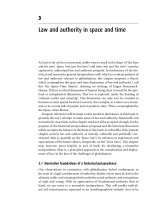Ch 5 rocks, fossils, and time
Bạn đang xem bản rút gọn của tài liệu. Xem và tải ngay bản đầy đủ của tài liệu tại đây (4.21 MB, 58 trang )
Ch. 5 Rocks, Fossils, and Time
ESCI 102
Geologic Record
• The fact that Earth has changed through time is apparent
from evidence in the geologic record
• The geologic record is the record of events preserved in
rocks
• Although all rocks are useful in deciphering the geologic
record, sedimentary rocks are especially useful
• We will learn to interpret the geologic record using
uniformitarianism
Geologic
Record
• Fossils in these
rocks provide a
record of climate
change and
biological events
• The rocks
themselves help
reconstruct the
environment
John Day Fossil Beds National
Monument,
Stratigraphy
• Stratigraphy deals with the study of any layered
(stratified) rock, but primarily with sedimentary
rocks and their
•
•
•
•
composition
origin
age relationships
geographic extent
• Sedimentary rocks are almost all stratified
• Many igneous rocks and metamorphic rocks are
also stratified
Stratified Igneous Rocks
•
Stratification in a succession of lava flows in Oregon
Stratified Metamorphic Rocks
• Stratification in Siamo Slate, in Michigan
Stratified Sedimentary Rocks
•
Stratification in sedimentary rocks consisting of alternating layers of
sandstone and shale, in California
Vertical Stratigraphic Relationships
• Surfaces known as bedding
planes
– separate individual strata from
one another
• Rocks above and below a bedding plane differ
– in composition, texture, color
– or a combination of these features
• The bedding plane signifies
– a rapid change in sedimentation
– or perhaps a period of nondeposition
Superposition
• Nicolas Steno realized that he could determine the
relative ages of horizontal (undeformed) strata by their
position in a sequence
• In deformed strata, the task is more difficult
– sedimentary structures, such as cross-bedding, and fossils
– allow geologists to resolve these kinds of problems
• more later in term
Principle of Inclusions
• According to the principle of inclusions
– inclusions or fragments in a rock are older than the
rock itself
• Light-colored granite
showing basalt
inclusions (dark)
• Which rock is older?
– basalt, because
the
granite includes
it
northern Wisconsin
Age of Lava Flows, Sills
• Determining the relative ages of lava flows, sills and
associated sedimentary rocks uses alteration by heat
and inclusions
• How can you determine whether a layer of basalt
within a sequence of sedimentary rocks is a buried
lava flow or a sill?
– a lava flow forms in sequence
with the sedimentary layers
• rocks below the lava will have
signs of heating but not the rocks
above
• the rocks above may have lava
inclusions
Sill
• How can you determine whether a layer of basalt
within a sequence of sedimentary rocks is a buried
lava flow or a sill?
– sill will heat the rocks above and below
– sill might also have
inclusions of the rocks
above and below
– but neither of these rocks
will have inclusions of
the sill
Unconformities
• So far we have discussed vertical relationships
among conformable strata
• sequences of rocks in which deposition was more or less
continuous
• Unconformities in sequences of strata represent
times of nondeposition and/or erosion that
encompass long periods of geologic time
– millions to hundreds of millions of years
• The rock record is incomplete
– interval of time not represented by strata is a hiatus
Origins of an Unconformity
• Deposition began 12 million years ago (MYA)
• Continuing until 4 MYA
• For 1 million years
erosion occurred
– removing 2 MY of
rocks
– and giving rise to a 3
million year hiatus
• The last column is the
actual stratigraphic
record with an
unconformity
Types of Unconformities
• Three types of surfaces can be unconformities:
– disconformity
• separates younger from older rocks
• both of which are parallel to one another (implies sed rx)
– nonconformity
• cuts into metamorphic or intrusive rocks
• is covered by sedimentary rocks
– angular unconformity
• tilted or folded strata
• over which younger rocks were deposited
Types of Unconformities
• Unconformities of regional extent may change from one
type to another
• They may not represent the same amount of geologic
time everywhere
Lateral Relationships
• In 1669, Nicolas Steno proposed the
principle of lateral continuity
– layers of sediment extend outward in all
directions until they terminate
– terminations may
be abrupt
• at the edge of a
depositional basin, and…
• where eroded
• where truncated by faults
Gradual Terminations
– or they may be gradual
• where a rock unit becomes
progressively thinner until it
pinches out
• or where it splits into thinner units
each of which pinches out, called
intertonging
• where a rock unit changes by lateral
gradation as its composition and/or texture
becomes increasingly different
Sedimentary Facies
• Both intertonging and lateral gradation indicate
simultaneous deposition in adjacent environments
• A sedimentary facies is a body of sediment
– with distinctive physical, chemical and biological
attributes deposited side-by-side with other sediments
in different environments
Sedimentary Facies
• On a continental shelf, sand may accumulate in the
high-energy nearshore environment
• Mud and carbonate deposition takes place at the
same time in offshore low-energy environments
∴ Different Facies
Marine Transgressions
• A marine transgression occurs when sea level rises with
respect to the land
• During a marine transgression
– the shoreline migrates landward
– the environments paralleling the shoreline migrate landward
• Each laterally adjacent depositional environment produces a
sedimentary facies
• During a transgression, the facies forming offshore become
superposed upon facies deposited in nearshore environments
Marine Transgression
• Rocks of each facies become younger in a landward
direction during a marine transgression
• One body of rock with the same attributes (a facies)
was deposited gradually at different times in
different places so it is time transgressive
– ages vary from place to place
older shale
younger
shale
A Marine Transgression in the Grand
Canyon
• Three formations
deposited in a
widespread marine
transgression are
exposed in the
walls of the Grand
Canyon
• What is the sea
level history
recorded?
Marine Regression
• During a marine regression, sea level falls
with respect to the continent
– and the environments
paralleling the shoreline
migrate seaward
Marine Regression
• A marine regression is the opposite of a marine
transgression
• It yields a vertical sequence with nearshore facies
overlying offshore facies and lithostratigraphic rock
units become younger in the seaward direction
older
shale
younger shale









